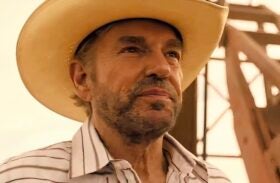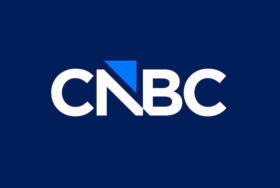
By E.B. Moss
For insights and observations from Miami, go here .
 A delightful dilemma was choosing between sessions on AI-driven creative strategies to explorations of the evolving streaming landscape, and keynotes with high-profile speakers including Martha Stewart, interviewed by iHeart’s Bob Pittman, and Katie Couric who chatted with Horizon Media Holdings CEO Bill Koenigsberg, tennis legend Stan Smith and rising sports star Flau’jae Johnson, entrepreneur Mark Cuban, and legions of media leaders – from the ubiquitous Gary V and Michael Kassan to chief marketers Frank Cooper III, Erin Condon and Tim Ellis, of Visa, CVS and the NFL, respectively. Natural comparisons were made to Cannes, with Possible’s version of the famed cabanas that line the Lions’ Boulevard de la Croisette being scores of poolside booths at the Fontainebleau from GumGum to Comscore, Pinterest to Teads. Select keynotes were streamed via X (Twitter), expanding the reach of the conference as Possible’s first-ever streaming partner, and paving the way for a mainstage chat with its CEO, Linda Yaccarino.
A delightful dilemma was choosing between sessions on AI-driven creative strategies to explorations of the evolving streaming landscape, and keynotes with high-profile speakers including Martha Stewart, interviewed by iHeart’s Bob Pittman, and Katie Couric who chatted with Horizon Media Holdings CEO Bill Koenigsberg, tennis legend Stan Smith and rising sports star Flau’jae Johnson, entrepreneur Mark Cuban, and legions of media leaders – from the ubiquitous Gary V and Michael Kassan to chief marketers Frank Cooper III, Erin Condon and Tim Ellis, of Visa, CVS and the NFL, respectively. Natural comparisons were made to Cannes, with Possible’s version of the famed cabanas that line the Lions’ Boulevard de la Croisette being scores of poolside booths at the Fontainebleau from GumGum to Comscore, Pinterest to Teads. Select keynotes were streamed via X (Twitter), expanding the reach of the conference as Possible’s first-ever streaming partner, and paving the way for a mainstage chat with its CEO, Linda Yaccarino.
Along with powerhouse speakers from brands like Walmart US and sponsorship from media giants like Google and tech providers like Basis, Possible offered insights plus some industry panache and hoped-for, but seemingly underattended “TableTalks” for brand marketers in the Miami heat amid the sprawling Expo & Activations area. For more attendee engagement outside of yacht-based dinners and offsites, a Drone Show was scheduled but converted to just a Laser Show due to high winds, prompting new DOOH vendor Heli-D to tout that “WE could have flown our helicopter with huge video banner if we’d known!” Early birders flew down the beach in a morning 5K while others enlisted in a Beach Cleanup.
“The vibe isn’t about waiting for the industry to agree, it’s about moving forward with what’s already working.”
At and between sessions, there was a throughline to some of the buzz. Jenny Wall, CMO of VideoAmp, noted, “There’s a quiet consensus taking shape. The vibe isn’t about waiting for the industry to agree, it’s about moving forward with what’s already working. Measurement isn’t just about data anymore, it’s about trust. The players gaining ground are the ones backing up their numbers and putting real validation in motion. You can feel the shift toward accountability across every screen.”
Ryan Nelsen, CMO of StackAdapt, had a similar observation. “You can hear it in every hallway conversation. Marketers aren’t asking if martech and adtech should connect anymore, they’re asking how fast they can make it happen,” he said. “At Possible, it’s clear the divide is closing quickly, especially as brands push to unify audience insights and media execution. The smartest conversations aren’t just about data anymore, they’re about decisions, and how to drive them end-to-end, from impression to inbox to impact.”
You could hear about the desire to make other kinds of impactful impressions on panels and breakouts, too. Even in an era where discussing equity can feel trepidatious, another throughline was on inclusiveness and even social responsibility, thanks to a dedicated track on “Social Impact & Purpose Driven Business.”
A Monday morning breakfast event invited “Advance Women” to kick off their event experience over lox and conversation about fostering change. Hollis Guerra and Sophia Westrich, who are advocating for women at every level and in every field, explained that expediting advancement and breaking down barriers starts with “getting women in the same room talking.”
The Female Quotient offered its renowned ‘respite-meets-roundtables’ alcove to continue the elevation of women via conversation, featuring panelists ranging from Sheereen Miller-Russell, EVP, Client Partnerships, Warner Bros. Discovery to 8X Olympian/Philanthropist, Shelly-Ann Fraser-Pryce.
“There’s nothing like brands to help tell stories”
Sports played a strong part in the agenda, as well.
In the back-to-back opening general sessions, NFL legend Ray Davis shared his life-changing experience as a foster kid being mentored by Big Brothers Big Sisters of America. He supported his moving life story with appreciation for the non-profit sponsors, and million-dollar donators like Ryan Detert of Influential, saying, “There’s nothing like brands to help tell stories. That’s the power each of you in this room has – to change lives.” He was followed by Olympic gold medalist Tara Davis-Woodhall getting attendees excited about both women’s sports and in a mindset for sponsoring the 2028 Los Angeles Olympics.
In a panel on how live sports streaming is revolutionizing fan engagement, Michael Laband, Group SVP, US Revenue Magnite, was joined by Tom Fochetta, SVP, DISH Media, and Sarah Harms, Vice President, Ads Marketing and Measurement, Roku, among others. All were in agreement that in today’s media landscape, marketers are missing out on key moments of fan engagement when they don’t buy live inventory programmatically. But with ad tech purpose-built for live streaming, advertisers can collaborate closely with media owners to access premium, scalable inventory that reaches their desired audience while maintaining the high-quality viewing experience that keeps fans watching.
“We all have data”
And speaking of programmatic, an outsized presence by tech vendors nonetheless meant a chance to learn about many new offerings, or at least competitive considerations in contextual to data-driven targeting and AI. By the end of the last day, Rob Wilk of Yahoo acknowledged, however, that we might be “tired of hearing about the data everyone has. We all have data. But a lot has been sold and resold multiple times.” He segued to Yahoo’s point of differentiation of true first part data and the signals that are built into it that make the difference, as a search engine that understands consumer desires in real time. The challenge for all presenters was to make their case for their own points of differentiation, and how that serves the customer.
One of those big customers, who happened to be on Wilk’s panel, was Shenan Reed, General Motors’ first-ever Global Chief Media Officer. She emphasized that to make a great consumer experience with all that data is to “Show up correct and provide value.”
Reed explained her “how”: “My customer base is about 4 to 5% of the US adult population each year, which is relatively small. That’s the percentage of people who are buying cars and who we need to keep top of mind—with the right vehicle, at the right moment. It’s about making sure we’re telling our story, getting it out there, but not wasting impressions on people who just bought a lease or already have a vehicle and won’t be in the market for a couple more years. People generally only buy cars every three to five years, depending on when their lease ends, or when something changes in their life that pushes them to get a new vehicle. So, my challenge on the media side is making sure our audience isn’t too broad or too big, but that we’re still staying top of mind. That’s why we’re constantly refining our audiences, leveraging data and technology, and then layering in creative. That’s where the magic happens.
“On top of that, we’re working on building unique reach at speed – especially at the local level – while minimizing excess frequency and avoiding consumer fatigue,” she added. “We need to reduce waste as much as possible but still reach as many people as we can. This year, I’ve got a lot of interesting pilots planned to build that unique reach quickly and efficiently, reducing duplication in our vehicle advertising efforts.”
Panel moderator Jeff Greenspoon, Chief Global Client Officer at dentsu, summed up his own perspective as, “it’s about innovation for our businesses,” adding, perhaps in homage to the GM tech, “but if we have the North star of what is the value in that moment, over time, and for a lifetime to the consumer, then ultimately that’s going to drive the enterprise value today, but also help build a brand that’s sustainable, has longevity and ultimately drives value over the long term.”
“Social media is now interest media”
GenZ hero Gary V, founder of Vayner Media, packed a ballroom leaned in for his presentation, which was basically five minutes of thought leadership followed by 20 minutes of an open mic “AMA” session. His key messages drove a stake through the heart of old school marketers.
First, “social media is now interest media. We are fully in that era.” A brand must test the waters and do what it takes to spark interest in social media. And, “20% of your whole marketing budget has to be allocated to social PRODUCTION. So before resurrecting the Jolly Green Giant [suggesting tentpoles and grand mascots have less ROI today] recognize that big companies are being outspent in that production by companies that didn’t exist a year ago.”
Then, attendees lined up to ask for his POV on social meets media, and his biggest answer? “Social media is now interest media. We are fully in that era.” And, in response to everyone’s million-dollar question of “how are you tracking the results,” he believes “the data is in black and white: the sales.”
Finally, a sobering point in answer to how GenZ will relate to AI generated influencers: “In 24 months they won’t know the difference.” And if you don’t know you won’t care.
But caring was top of mind for a panel on Curation and Sustainability moderated by the resonant Bob Regular, CEO, Infolinks, who posed a question of how to navigate the incredible amount of noise generated by the ad industry, with “billions of low quality impressions and very poor signal.”
“How does AI make it all better?”
Scope3’s Brian O’Kelley aims to clean up the noise and reduce the environmental impact while upping the efficiency of advertising and media through open-source methodologies to measure and mitigate their carbon footprint. He acknowledges “how complicated and challenging it can be to really make any kind of digital advertising work.”
“So,” he adds, “with the AI based technologies on Meta or Google, or on Microsoft, these more closed ecosystems can control every aspect of the experience and can make sure the placement is good. They can make sure the user is legitimate. They can actually find the people who are most likely to like the ad. All the things that get between an advertiser trying to find an audience or the most effective content to reach that audience. To me, when we talk about curation, are we talking about a human or large language model making those decisions? Are we talking about a shorter supply path and better connections between identity or signals? I think that’s a question for all of us – how can we compete with YouTube or compete with Meta. They’ve set the bar. But how can we make this work better?”
It’s a data question, too, in answer to the challenge, according to Elizabeth Neubauer-Donovan, SVP, Global Head of Commerce & Retail Media Networks at Acxiom Kinesso: “Having your data ready, organized, accessible, and actionable is the foundation for effective media curation, smarter advertising, and ultimately, the reduction of ad waste.”
“We are at a place where impossible is possible”
While many of the dozens of sessions incorporated talk of AI, O’Kelley put a fine, if long, point on the net net essence of that and, in fact, Possible: “How does AI make it all better? The best media, the best content, the best moments to connect with people. And we’re doing this at Internet scale, at global scale. There’s a lot of people on this earth. And so it’s very difficult to imagine any of us figuring this all out, but if we can enhance some of our knowledge, some of this data, and effectively telling an agent what to do, imagine if that agent can run every piece of content on the Internet, on every web page, on every podcast, understand every aspect of every show on Netflix, in the data catalog, understand every sub segment of every bit of retail data. That’s an massive undertaking.
“We are at a place where impossible is possible. And we’re at Possible! The thing that I’m obsessed about is how do we get our heads into this future that’s possible? How do we reimagine businesses that way? How do we start to deploy technology that lets us do what we’ve always imagined and pull ourselves out of how it works today?
“From my perspective, you should be asking yourself, What can I do now but I couldn’t do before? But how can I turn that into value for myself, for my clients, for everyone in this ecosystem? Because that will define the next 48 months. It’s human intelligence at Internet scale for the very first time.
“We can’t be afraid of using AI because of the environment. But we can’t use it willy nilly. You can’t not use energy; it’s part of our job. You just have to be thoughtful about how you use it.”







